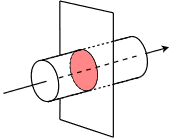1.3: Charge and Current
- Page ID
- 98378
\( \newcommand{\vecs}[1]{\overset { \scriptstyle \rightharpoonup} {\mathbf{#1}} } \)
\( \newcommand{\vecd}[1]{\overset{-\!-\!\rightharpoonup}{\vphantom{a}\smash {#1}}} \)
\( \newcommand{\id}{\mathrm{id}}\) \( \newcommand{\Span}{\mathrm{span}}\)
( \newcommand{\kernel}{\mathrm{null}\,}\) \( \newcommand{\range}{\mathrm{range}\,}\)
\( \newcommand{\RealPart}{\mathrm{Re}}\) \( \newcommand{\ImaginaryPart}{\mathrm{Im}}\)
\( \newcommand{\Argument}{\mathrm{Arg}}\) \( \newcommand{\norm}[1]{\| #1 \|}\)
\( \newcommand{\inner}[2]{\langle #1, #2 \rangle}\)
\( \newcommand{\Span}{\mathrm{span}}\)
\( \newcommand{\id}{\mathrm{id}}\)
\( \newcommand{\Span}{\mathrm{span}}\)
\( \newcommand{\kernel}{\mathrm{null}\,}\)
\( \newcommand{\range}{\mathrm{range}\,}\)
\( \newcommand{\RealPart}{\mathrm{Re}}\)
\( \newcommand{\ImaginaryPart}{\mathrm{Im}}\)
\( \newcommand{\Argument}{\mathrm{Arg}}\)
\( \newcommand{\norm}[1]{\| #1 \|}\)
\( \newcommand{\inner}[2]{\langle #1, #2 \rangle}\)
\( \newcommand{\Span}{\mathrm{span}}\) \( \newcommand{\AA}{\unicode[.8,0]{x212B}}\)
\( \newcommand{\vectorA}[1]{\vec{#1}} % arrow\)
\( \newcommand{\vectorAt}[1]{\vec{\text{#1}}} % arrow\)
\( \newcommand{\vectorB}[1]{\overset { \scriptstyle \rightharpoonup} {\mathbf{#1}} } \)
\( \newcommand{\vectorC}[1]{\textbf{#1}} \)
\( \newcommand{\vectorD}[1]{\overrightarrow{#1}} \)
\( \newcommand{\vectorDt}[1]{\overrightarrow{\text{#1}}} \)
\( \newcommand{\vectE}[1]{\overset{-\!-\!\rightharpoonup}{\vphantom{a}\smash{\mathbf {#1}}}} \)
\( \newcommand{\vecs}[1]{\overset { \scriptstyle \rightharpoonup} {\mathbf{#1}} } \)
\( \newcommand{\vecd}[1]{\overset{-\!-\!\rightharpoonup}{\vphantom{a}\smash {#1}}} \)
Dynamic current
In electrical circuits, the relationship between current and change is governed by calculus, specifically differentiation. Current (I) is the rate of flow of electric charge, and it is defined as the change in charge (Q) with respect to time (t), denoted as I=dQ/dt. This relationship is based on the fundamental principle that current is the flow of charge over time.
Example: Finding Current when Charge is a Function of Time
Consider a scenario where the charge (Q) on a capacitor is a function of time (t), expressed as Q(t) = 2t2 + 3t + 5 coulombs. To find the current (I) at a specific time, we differentiate the charge function with respect to time. By applying the rules of calculus, we find the derivative:
\[ I(t) = \frac{dQ}{dt} = \frac{d}{dt}(2t^2 + 3t + 5) \]
The resulting expression I(t) = 4t + 3 represents the current as a function of time. If you want to find the current at a particular moment, substitute the time value into the equation. For example, to find the current at t=2 seconds:
\[ I(2) = 4×2+3 = 11 Amperes \]
The quantity of charge transferred between two specific time points, t1 and t2, can be determined by integrating the current function over the given time interval. The integral of the current function I(t) with respect to time over the interval [t1 , t2] provides the total charge transferred (Qtotal) during that period:
\[ Q_{\text{total}} = \int_{t_1}^{t_2} I(t) \, dt \]
Continue from the above example, we can find the total charge transferred between t1=1 second and t2=3 seconds.
\[ Q_{\text{total}} = \int_{t_1}^{t_2} (4t + 3) \, dt = 22 C \]



